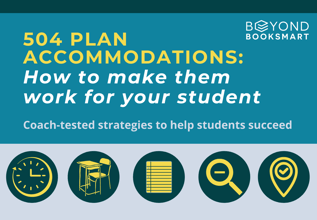If you’ve worked hard to get your child approved for a 504 plan for their ADHD, there can be a “phew!” moment after all those documents are signed. And while it’s a good move forward in leveling the playing field for your child, it’s really just the first step in a more comprehensive process of supporting your child’s academic performance.
Wait - what? (In case you’re new to the world of 504 plans, this article has some helpful info.)
 You see, 504 plans generally do not guarantee individualized support that helps students truly use their accommodations for their intended purpose. It’s kind of like having a recipe that lists the ingredients without the detailed instructions for how to prepare those ingredients. Let’s take a look at some typical accommodations seen on 504 plans.
You see, 504 plans generally do not guarantee individualized support that helps students truly use their accommodations for their intended purpose. It’s kind of like having a recipe that lists the ingredients without the detailed instructions for how to prepare those ingredients. Let’s take a look at some typical accommodations seen on 504 plans.
The “ingredients” list for supporting a particular student with ADHD might look something like this:
- Extra time on tests and/or access to a quiet area for test-taking
- Preferential seating (i.e., front of the classroom)
- Class notes are provided for the student
- Reduced homework assignments (i.e., every other problem on a math worksheet)
- End-of-day check-ins with a teacher to ensure the student has all materials needed to complete homework assignments
All these look pretty useful on the surface, right? And they certainly can be game-changing for many students. But do you see what’s missing? Let’s dig a little further into each accommodation we listed to uncover what’s been left out…
Extra Time on Tests: 4 Ways to Make it Work for Your Student
Your child may get granted extra time and/or a separate room to take tests - which seems like a good solution to their challenges with managing time and attention - but what are the strategies your child will use while taking tests that will best leverage that extra time and distraction-free area? Depending on the student, they could:
- Read through the whole test first in order to decide which section is worth more points and deserves a top priority to tackle first.
- Do a “brain dump” first and write down all the info they might want to keep in mind before even starting the assessment, especially if they get anxious about test-taking.
- Assign a time guideline to each section before they start so they are not spending too little or too much time on a given area of the test.
- Prepare for essay questions by anticipating 3 possible prompts, so they can efficiently draw upon their active studying during the test.
Now that you’re seeing that “extra time” or “separate room for test-taking” can be pretty empty in the absence of explicit instruction on how to use that time and space effectively, let’s look at some more strategies that might complement your child’s 504 accommodations.
Preferential Seating: 5 Ways to Make it Work for Your Student
Your child may be entitled to preferential seating in classes to help them maintain their focus - but what personal strategies will they use to keep themselves on task while they sit in that front row? Depending on your student’s needs, they may:
- Remove all items off their desk except notebook and pencil
- Pop a strong mint in their mouth at the start of class to enhance their alertness
- Have a goal of contributing to class discussions or asking questions a certain number of times per class
- Place a brightly colored post-it note on their desk as a reminder to focus on their work
- Be mindful of keeping their eyes on the teacher
Provided Class Notes: 4 Ways to Make it Work for Your Student
Your child may be provided with notes from class - but how will they go about determining what information is important and whether they are comprehending the material? They may need to:
- Take their own notes and compare them afterward to see what information they may have missed
- Write down questions they have during class and review the provided notes for answers
- Write their own summaries of provided class notes
- With a peer or teacher, highlight key ideas in provided notes
Workload Reduction: 4 Ways to Make it Work for Your Student
Your child may be granted a workload reduction in their homework assignments (i.e., every other problem on a math worksheet or only odd-numbered questions at the end of a history chapter) - but how will they work toward building their focus, stamina, and ability to get started? Some students may benefit if they:
- Strategize their homework so they do the most difficult assignments first
- Set small rewards for themselves upon completion of an assignment
- Try a 5-minute goal, if getting started is difficult
- Minimize distractions by putting their phone in a different room
Teacher Check-ins: 5 Ways to Make it Work for Your Student
Maybe your child was granted an end-of-day check-in with a teacher to ensure they have what they need to complete their homework assignments. Now, what strategies will they be learning to make the most of those check-ins - and to help them become more independent over time? Your child may:
- Work with the teacher to create a customized materials checklist
- Create an action plan for completing their homework
- Use this time to reflect on their day and anticipate the next day
- Make a plan for bringing back and passing in completed homework
- Chunk out a larger assignment or project with the teacher
Clearly, there’s a big difference between simply getting an accommodation for ADHD at school and developing and applying essential skills, strategies, and tools to become a more effective learner. As Executive Function coaches, we often work with students who have 504 plans, yet are still struggling to fully gain the benefits of those accommodations that parents have worked so hard to have in place. We love helping students make the leap from just having the ingredients for leveling the playing field to having the recipe for real success in school and beyond. And that creates a feast of opportunity to accomplish almost any goal you can imagine (see what I did there?).

Download our infographic on 504 plan accommodations for an easy and shareable reference.
Photo by Kuanish Reymbaev on Unsplash

